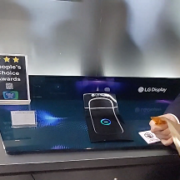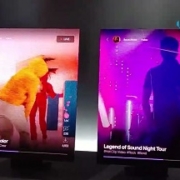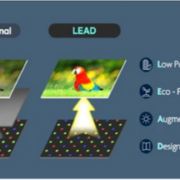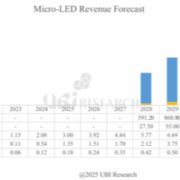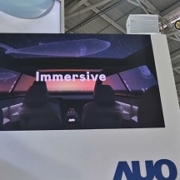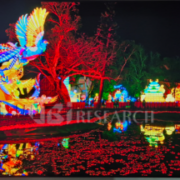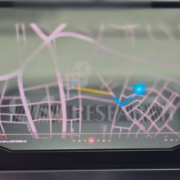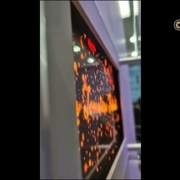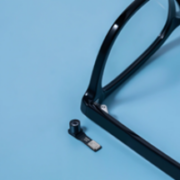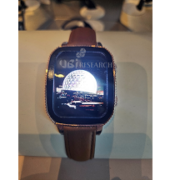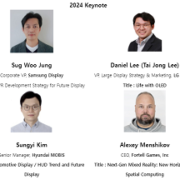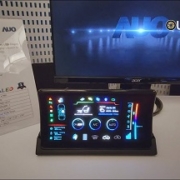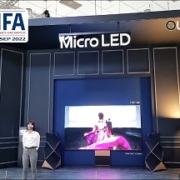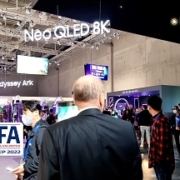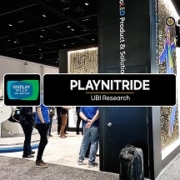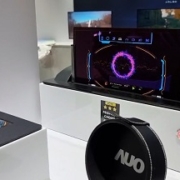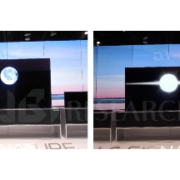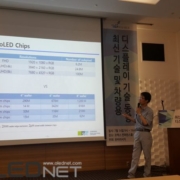Posts
Preview of SID 2025
/in Display, Display, Display, Display, Display, Display, Display /by UBIResearchNetSamsung Display’s ‘LEAD™’, the world’s first non-polarized OLED technology commercialized, has won the ‘Displays of the Year (DIA)’ award from the Society for Information Display (SID). ‘LEAD™’ is an OCF (On Cell Film) technology that replaces the polarizer, an opaque plastic sheet, and has been praised for improving brightness, enhancing outdoor visibility, and making the panel 20% thinner.
Samsung Display is actively marketing its proprietary technology to the market through the brand name ‘LEAD™’, which includes the four representative characteristics of this technology: ▲Low Power Consumption ▲Eco-Friendly ▲Augmented Brightness ▲Designed to Slim & Light.

SDC LEAD™ Technology
LG Display plans to showcase the world’s best vehicle display optimized for future mobility under the theme of ‘Expanding business through new technology (Driving the future)’.
With ▲Vehicle stretchable display solution that can display all spaces in a vehicle, it proposes design innovation possibilities suitable for future mobility. The stretchable display, which implements high-resolution 100ppi (pixels per inch) and red, green, and blue (RGB) full colors at the same time as a general monitor while the screen can be stretched by up to 50%, has been applied to the center fascia area of the vehicle to maximize aesthetics and convenience.
LG Display, which recently succeeded in commercializing the world’s first ’40-inch pillar-to-pillar’, is exhibiting ▲57-inch vehicle pillar-to-pillar, the world’s largest single panel. ▲18-inch sliderable OLED unfolds from the ceiling down only when needed. It implements entertainment functions with OLED’s unique three-dimensional picture quality and provides a new mobility experience. In the trend of larger vehicle displays, we introduce ▲SPM (Switchable Privacy Mode) mode, a key technology that enhances safety by controlling viewing angles.

LG Display Automotive Stretchable Micro-LED Display
Chang Wook HAN, VP/Analyst, UBI Research(cwhan@ubiresearch.com)

Micro LED technology, when will it play a leading role in next-generation displays?
/in /by olednetOver the past few years, we have analyzed trends in micro-LED technology and products. Along with the advancement of mini-LED backlight technology, micro-LED has emerged as the next-generation display technology, and interest is growing in when micro-LED will enter the mainstream market. Major display companies and research institutions in countries such as China, Taiwan, South Korea, the United States, and Europe have been accelerating technology development and product commercialization through years of investment, achieving a significant transition from the laboratory stage to mass production. However, the market share of micro-LED in the overall display market remains low, and the pace of commercialization as a mainstream product is still slow.
Samsung Electronics has been leading the way in next-generation display technology with its giant micro-LED TV, ‘The Wall,’ for several years now. Now, with price competitiveness and production efficiency improvements, the company is at a point where it needs to expand into the consumer market in earnest.
Taiwan’s AUO recently showcased automotive micro-LED displays and mirror displays at CES and Touch Taiwan, focusing on targeting the B2B market. The company aims to begin mass production of its 4.5-generation micro-LED production line this year. PlayNitride is preparing to mass produce panels for smartwatches and AR glasses based on its high-brightness, high-resolution technology.
Chinese companies BOE, TCL CSOT, and Tianma are expanding their demonstrations and investments in micro-LED panels and are leading the way in preparations for mass production. BOE’s subsidiary HC SEMITEK is promoting the construction of a micro-LED Epi wafer manufacturing, chip production, and packaging base in Zhuhai City, and at the end of last year, it announced the start of production of a 6-inch substrate micro-LED mass production line. TCL CSOT is preparing to enter the TV and automotive display markets through a joint research institute established with Sanan in 2020 and a joint venture, Extremely Display, to develop and commercialize products. Tianma completed its TFT-based micro-LED production line in December last year and is ready to begin small-scale shipments in phases starting this year. In addition to leading in mass production speed, the company is also accelerating technological advancements such as improving yield rates for 6-inch wafer Micro LED, enhancing laser transfer efficiency, and refining precise tiling bonding. This has been confirmed through the company’s efforts to showcase technological improvements and strengthened productization at technology exhibitions.
At the international business conference ‘OLED & XR KOREA 2025’ hosted by UBI Research, presentations on Micro-LED technology and market trends were provided for TV/large-screen displays, AR, smartwatches, and automotive displays.
According to UBI Research’s analysis, the Micro-LED consumer market is expected to be driven by TVs and AR glasses by 2027, with smartwatches and automotive displays gaining market share by 2028. It is predicted that Micro-LED will break into the mainstream market around 2028, moving beyond premium product segments.

More detailed information and technical analysis will be provided in a report to be published by UBI Research at a later date.
Nam Deog Kim, UBI Research Analyst(ndkim@ubiresearch.com)

Taiwanese company’s Micro-LED Display technology showcased at Touch Taiwan 2025 with various applications and commercialization possibilities
/in Exhibition /by olednetMicro-LED display technology leaders AUO, Innolux, and PlayNitride showcased their latest technologies at Touch Taiwan 2025 on April 16 to demonstrate the wide range of applications and commercialization possibilities of Micro-LEDs. They showcased products for large displays and automotive solutions, as well as a variety of other applications.
AUO’s Micro LED presented exhibits in two areas, “Display” and “Mobility Solutions”, showcasing AUO’s technological innovations in the field of advanced displays. The company exhibited a 114-inch Micro LED TV developed in collaboration with Samsung Electronics, and also introduced a 127-inch TV tiled with eight 42-inch single modules, the world’s largest in-house development.

127” Micro-LED TV (Resolution: 3840×2160, 1000nit, Pixel Pitch: 0.732mm)
In addition, the 17.3-inch double-sided transparent Micro-LED display (shown below) is an application that can display different information on both sides, creating interactive services on both sides. Displays like this can also be used in many applications, such as commercial advertising, home decor, and more, where they can convey information while enhancing the style of the display.

17.3” Dual-side Transparent Micro-LED Display (left), Application case(right): from AUO
When it comes to smart mobility solutions, AUO, together with its subsidiary BHTC, demonstrated the vision and possibilities of various automotive display applications, including Virtual Sky Canopy, XR Interactive Window, Morphing Center Control, Foldable Cruise Pilot, and Horizon Image Glass. (Shown below)
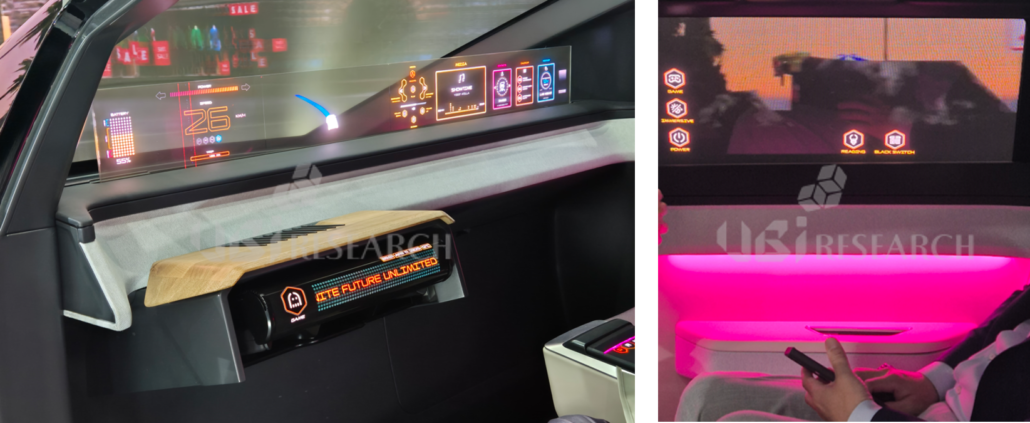
Other leading technologies include a 13-inch 3D AR heads-up Micro-LED display and a 14.6-inch flexible Micro-LED touch display with haptic capabilities.
Innolux’s Micro-LEDs were front and center at the booth with a 204-inch 8K Micro-LED display and a 130-inch foldable Mini-LED 4K TV (shown below). Other products included a 1.39-inch touch-embedded wearable Micro-LED display, Micro-LED mirror products, transparent displays, and Micro-LED floating displays. In the automotive application area, Innolux exhibited various automotive displays under the brand of their subsidiary CarUX. Among them, the Light Field Projective display with 9.6-inch Micro-LEDs was introduced.
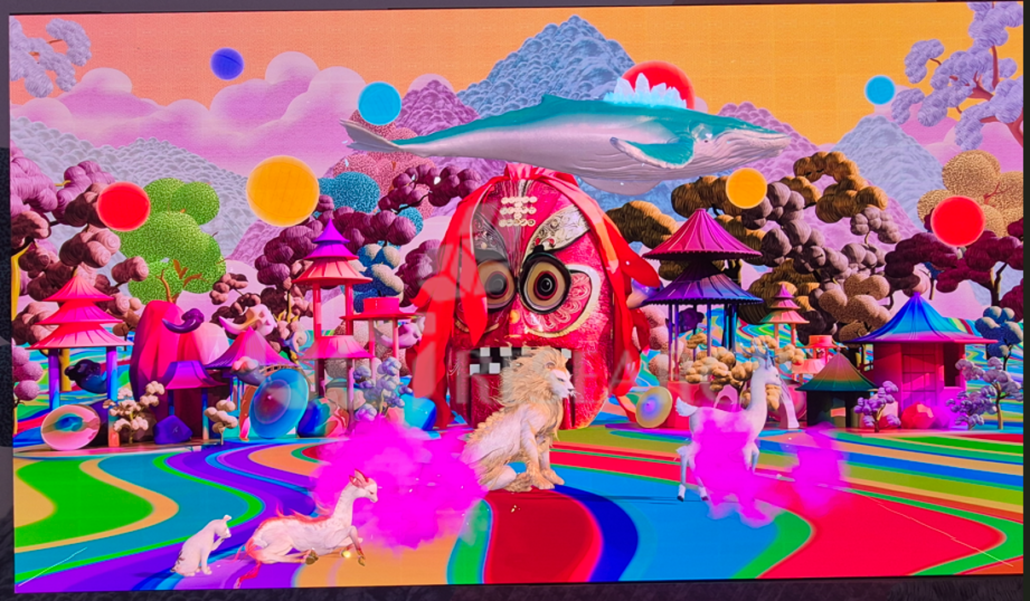
Innolux, 204” 8K Micro-LED Display
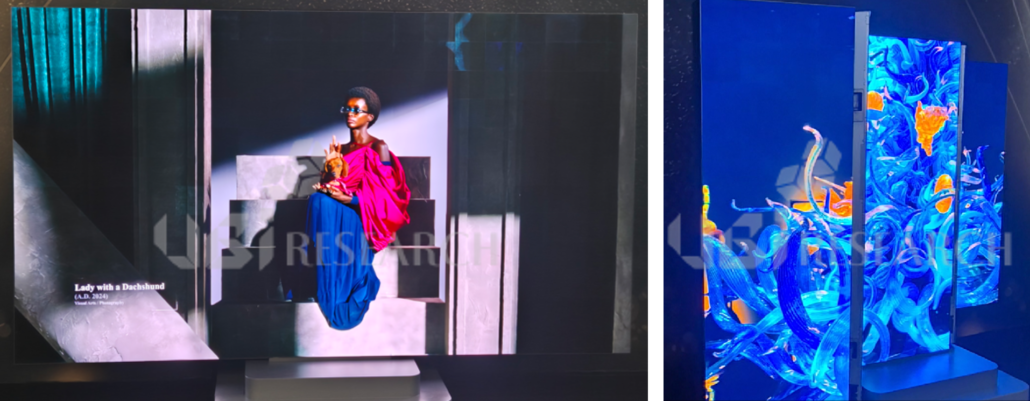
130” foldable Mini-LED 4K TV (left: unfolded view, right: folded view)
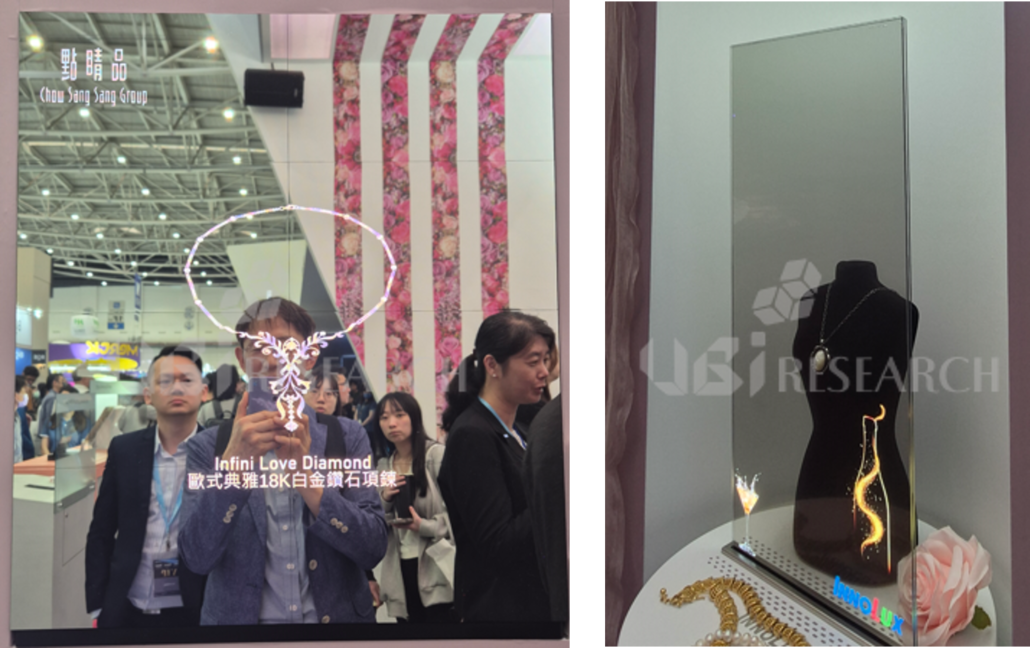
Micro-LED Mirror Product (left) and Transparent Display (right)
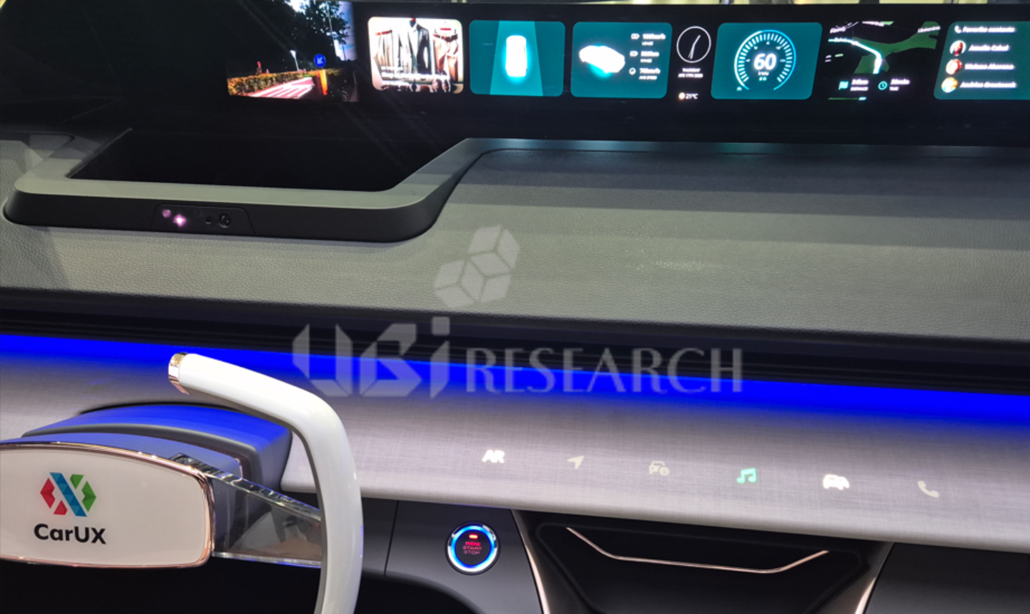
Innolux, 48” Windshield Reflective Solution
In addition to the 89-inch Micro-LED TV product developed in collaboration with Samsung, PlayNitride has developed a 1.39-inch Tantium Micro-LED display with a high brightness of 5000nits, a high brightness 8.07-inch transparent display, and a 0.18-inch high brightness (>500,000nits), high resolution (5,644 PPI, 720×720) and full color display for AR glasses based on its own technology platform. In addition to technology improvements, they also introduced applications such as a 9.38-inch floating display and a 3D display developed in collaboration with outside companies.
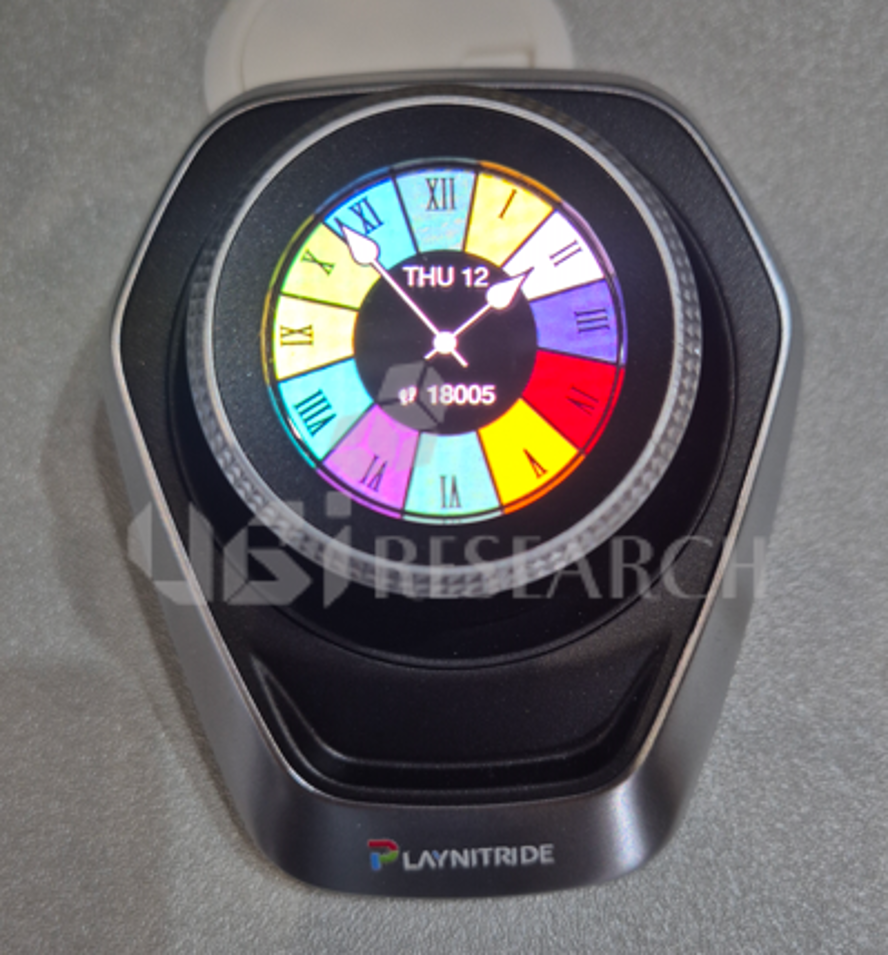
1.39” (326PPI, 5000 nits) Tantium Micro-LED Display Product
More details and technical analysis will be presented in a forthcoming Micro-LED report from UBI Research.
Nam Deog Kim, UBI Research Analyst(ndkim@ubiresearch.com)

Chinese Tianma company accelerates development of Micro-LED display technology and products
/in /by olednetThe ICDT2025 conference was held from March 23rd to 25th in Xiamen, China. Among the exhibitors, Tianma company exhibited more Micro-LED products than other companies, showing that Tianma is the most active in product development among Chinese companies. Of course, in addition to Micro-LED, Tianma also exhibited automotive display products using LCD technology and OLED technology at the ICDT 2025 conference to showcase its technology.
The main Micro-LED products exhibited by Tianma are as follows. First of all, in terms of Micro-LED products, in addition to normal transparent displays, transparent Micro-LEDs with low-reflection technology and 27” Micro-LEDs for TVs and large screens (Tiling method) were exhibited. In addition, an 8” HUD screen for automobiles was exhibited using a Micro-LED panel with a brightness of 10000 nits.
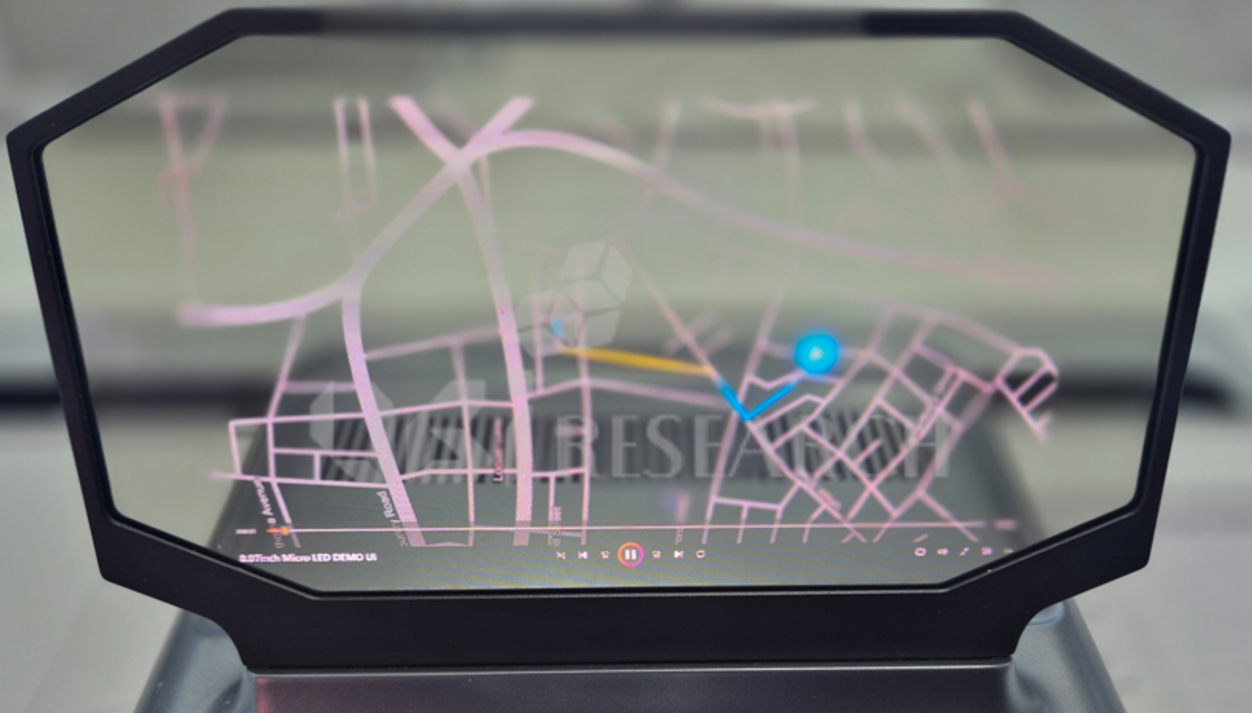
8.07” Low-reflective Transparent Micro-LED Display
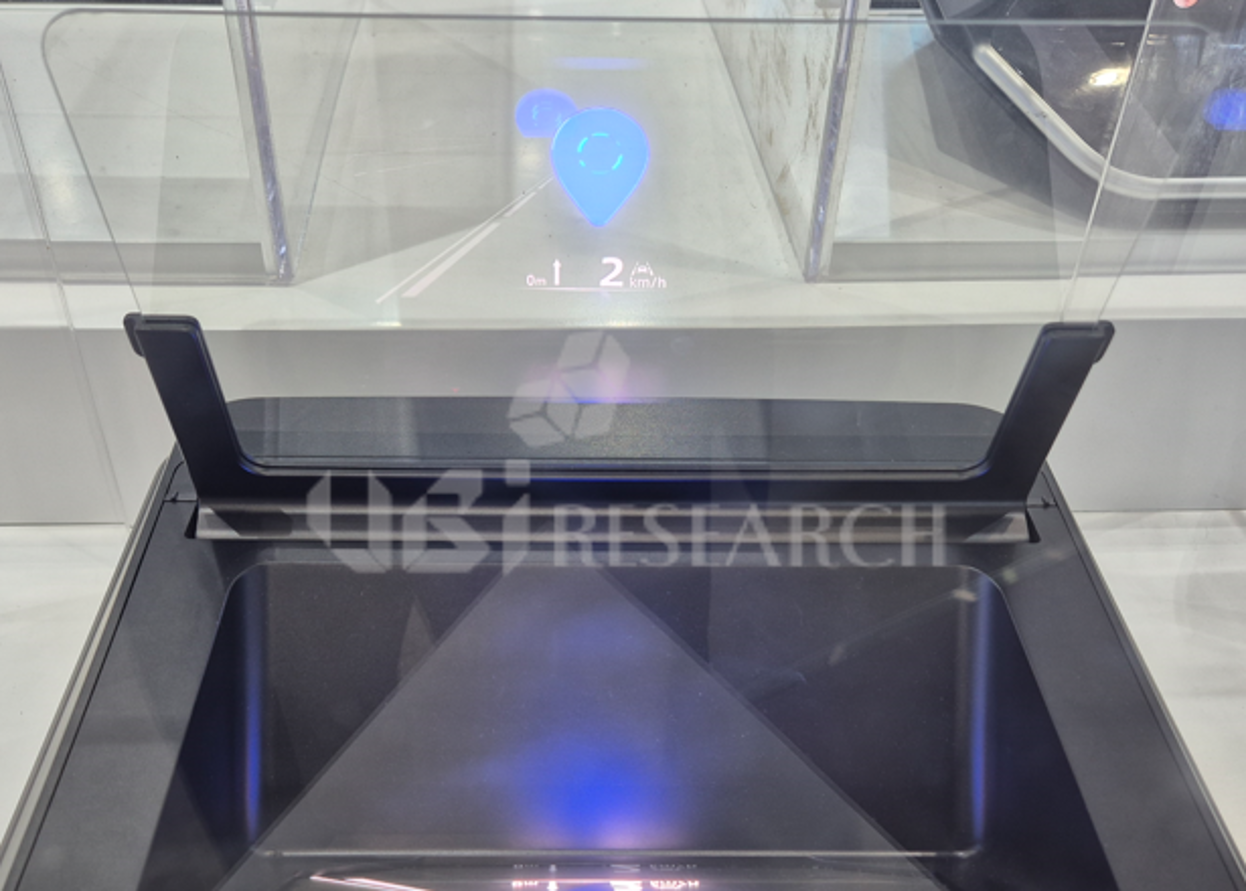
8.0” HUD Application Display (10,000 nits luminance)
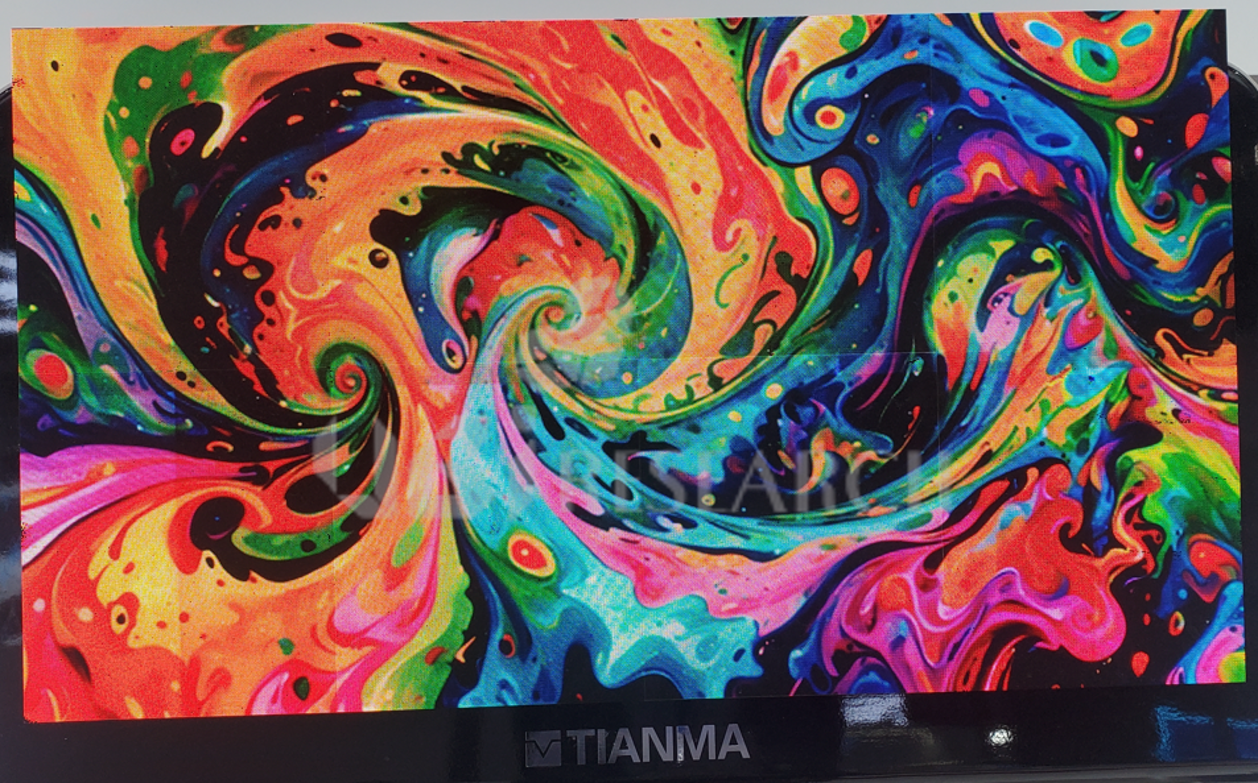
27” Splicing Micro-LED Display
The 27“ Micro-LED panel is made by stitching together a 7.5” screen with P0.4 mm, and the number of stitches can be increased to create video wall and commercial display applications. At the conference, we also presented Micro-LED efficiency enhancement technology and mass-transfer technology, showing that we are very active in technology development. These will be detailed in UBI Research’s Micro-LED technology report this year.
Through the project to build a micro-LED production line in Xiamen City, China, Tianma invested in equipment in March 2022 and is now equipped with a 3.5-generation micro-LED automation line. Based on Tienma’s LTPS technology, the company is accelerating technology development across the entire Micro-LED process and commercialization of automotive, tiling, and transparent display modules.
Nam Deog Kim, UBI Research Analyst(ndkim@ubiresearch.com)

“AI/AR Glasses Growth, Significant Expectations for the Development of Micro-LED Displays”
/in /by olednetAI technology is making a soft landing and the AI era is opening up. Recently, the competition among big tech companies to become the winner of the AI war has become more intense. It is expected that the multimodal technology of AI will renew the market’s perception of AI functions through interactions such as voice, video, and photos. AI/AR glasses are expected to be more popular as they have a viewing function and are equipped with various sensors such as cameras, microphones, and speakers to access data, voice, or displays in real time to complete interactions. Accordingly, AI/AR glasses have received a lot of attention in the past year.
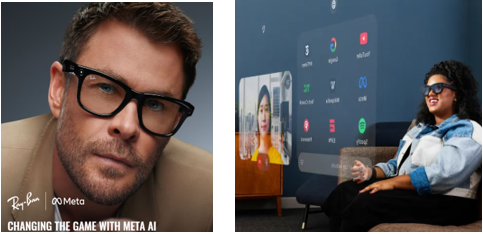
Ray-Ban META AI Glasses (left) and META Orion AR Glasses Prototype (right) (source: META)
The Ray-Ban smart glasses can be seen as Meta’s present, and the Orion project as its future. In September 2024, Meta unveiled the Orion glasses prototype, showcasing the new possibilities of AR glasses with innovative display technology. Micro LED was adopted as the display solution for the Orion AR glasses. AR glasses require ultra-high brightness (5,000 nits or more, ideally 10,000 nits or more) to be visible in outdoor environments. In addition, micro-LEDs are essential for lightweight, compact display engines that are required for AR glasses to be very slim and stylish when they are worn.
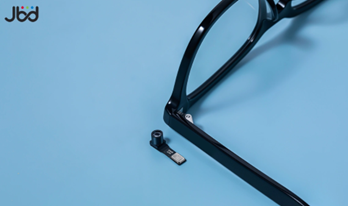
JBD “Hummingbird Mini II” mono-color engine (0.15cc, 0.3 grams) and daily-use glasses (source: JBD)
“AI” was the highlight of CES 2025, and AI smart glasses were one of the main attractions. Companies such as Vuzix, Rokid, Goertek, and RayNeo introduced new AI glasses products that use micro-LEDs.
Among the manufacturers of micro-LED displays, China’s Jade Bird Display (JBD), a company specializing in micro-LED microdisplays, has begun mass production at its facility in Hefei with a manufacturing capacity of more than 100 million 0.13-inch micro-LED panels per year. In addition to US and European companies, Chinese and Taiwanese companies such as Sitan and Raysolve are moving quickly to develop and prepare for the production of LEDoS displays. At UBI Research’s seminar held on on February 14, a presentation was given on micro-LED technologies for XR and trends in the industry. AI glasses began to blossom in 2024 with the development of AI and AR technology, and more large manufacturers are expected to enter the market in 2025. AI/AR smart glasses are expected to promote the accelerated development of the AI/AR industry, and there are high expectations for the development of micro-LED technology.
UBI Research published a report on micro-LED technology for XR in January. This report summarizes the technology related to the production of LEDoS panels required for XR glasses. It will help to improve the understanding of LEDoS’s micro-LED technology and will be an important reference for companies developing micro-LED display technologies to plan the future direction of technological development.
UBI Research Nam Deog Kim Analyst(ndkim@ubiresearch.com)

Samsung Display’s First Micro LED Watch
/in Display /by olednetCES 2025 in Las Vegas set the stage for Samsung Display’s private booth at the Encore Hotel. Among its cutting-edge OLED technologies, the highlight was the rare appearance of Micro LED. After years of quiet development, Samsung Display debuted its Micro LED for watches for the first time
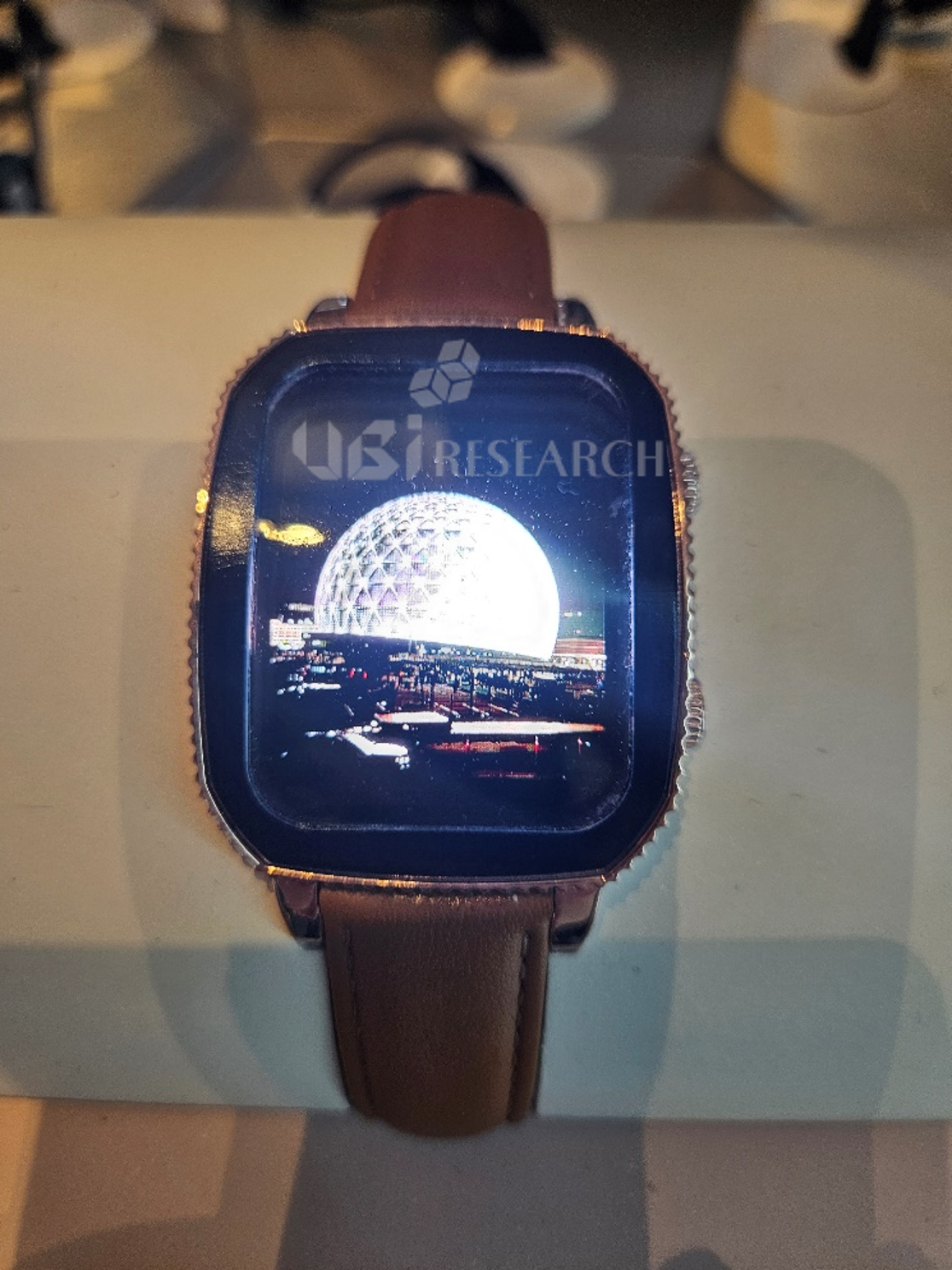
Samsung Display’s Micro LED features a 2.1-inch size, a resolution of 418×540, and a pixel density of 326 PPI, delivering a brightness of over 4,000 nits.
International Business Conference: 2024 OLED Korea & 2024 eXtended Reality Korea will be held in parallel!
/in /by olednet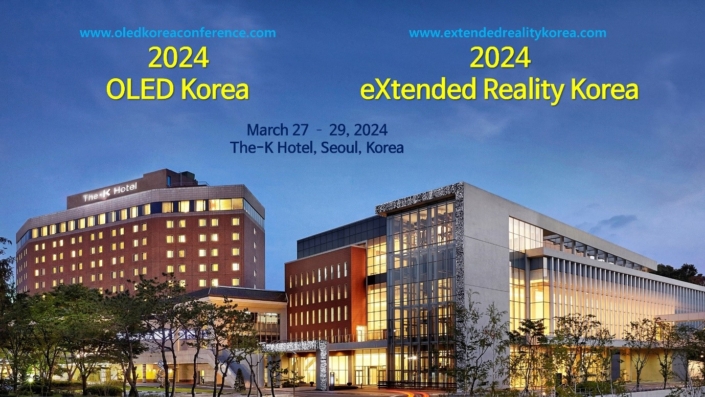
UBI Research, a display specialist research company, will hold the international business conferences OLED Korea and eXtended Reality Korea in parallel at The-K Hotel in Yangjae, Seoul from March 27 to 29, 2024. This event is expected to be an opportunity for people from companies, academia, and research institutes related to the display industry around the world to attend, exchange the best information, and form a global network.
eXtended Reality Korea is the first XR industry-related business conference held by UBI Research and will cover trends and outlook on micro display, XR Hardware/Software, materials, equipment, etc.
This event aims to provide attendees with the opportunity to deeply explore the display and XR areas through a comprehensive program including tutorials, keynote presentations, and panel discussions.
The tutorial on March 27th will feature presentations on the future of XR, micro LED display technology, and key technologies to realize the next generation OLED display.
In addition, keynote presentations by ▲UBI Research, ▲Samsung Display, ▲LG Display, ▲Hyundai Mobis, and ▲Fortell Games are scheduled for the conference to be held on March 28th and 29th. Choong-Hoon Yi, CEO of UBI Research, will give a presentation on “OLED and XR industry outlook.” We will present the overall OLED industry, including OLED for IT, and the micro OLED industry that will be applied to MR equipment.
Samsung Display plans to introduce SDC’s roadmap for expanding the AR/VR market based on SDC’s plan to overcome technical obstacles in ultra-high-resolution displays under the title “AR/VR Development Strategy for Future Display.”
Under the theme of “Life with OLED,” LG Display will examine the field of OLED displays applied in daily life and present the continuous evolution and benefits of OLED technology.
Under the theme of “Automotive Display / HUD Trend and Future Display,” Hyundai Mobis presents trends and requirements for automotive displays, from Pillar To Pillar displays to Rollable displays, predicts future automotive displays, and announces development strategies.
Lastly, Fortell Games will discuss the topic of “Next-Gen Mixed Reality: New Horizons for Spatial Computing”, analyzing the latest developments in mixed reality technology and their impact on the future of the gaming industry.
In addition, it will be run by a total of 34 domestic and foreign speakers and programs, including AR/VR development and technology, automotive displays, OLED industry, backplane technology, and MicroLED display development.
Because it is a parallel event, attendees can attend both events even if they register for one event, and registration is possible at a special discount price during the early bird period until February 29th.
Detailed information can be found on the website (https://oledkoreaconference.com/, https://extendedrealitykorea.com/).
[2022 Vehicle Displays] AUO (22 inch AmLED, 9.4 inch Flexible Micro LED)
/in Video, Video, Video, Video, Video, Video, Video, Video /by olednet22 inch Passenger Display : Active Privacy
– Specifications –
LCD Tech : AHVA / LTPS / VAC
Resolution (pixel) 4K 1K
Active Area : 539mm (H) x 95mm (V)
Privacy Performance : Brightness 1.65% at H = 25⁰
Color Depth : 24 bits
Color Gamut 72% NTSC
Curvature : R3000 -Concave
Brightness : 600 cd/m²
9.4 inch Flexible Micro LED Display
– Specifications –
Resolution (pixel) : 1920 x 960
Refresh Rate : 60 Hz
Brightness : > 2000 cd/m²
Contrast Ratio : 1,000,000 :1
Color Gamut : 120% NTSC
Pixel Configuration : Real RGB Stripe
Display L/R border : 3mm
ViewingAngle (U/D/L/R) : 179° / 179° / 179° / 179°
LED Size : > 30um
[IFA 2022] LG Electronics Micro LED TV, QNED 8K TV(MiniLED)
/in /by olednet#ifa2022 #lg #ledtv

https://ubiresearch.com/en/

https://en.olednet.com/

marketing@ubiresearch.com
+82-2-577-4391
[IFA 2022] Samsung Booth (MICRO LED, Neo QLED)
/in /by olednet#ifa2022 #samsung #qled

https://ubiresearch.com/en/

https://en.olednet.com/

marketing@ubiresearch.com
+82-2-577-4391
[SID 2022] AUO 14 6” Rollable Micro LED Display Display Week 2022
/in Oled Video /by olednetResolution (pixel) : QHD (2560 x RGB x 1440)
Pixel Density : 202PPI
Brightness :1,000 cm/m²
Contrast Ratio : 1,000,000 : 1
Color Gamut : 100% NTSC
Pixel Configuration : Color Conversion
Viewing Angle : 179° / 179° / 179° / 179°
LED Size : 30um
CES2019, the Biggest Issue of TV is LG Electronics OLED TV R
/in Focus on, Focus on, Focus on, Focus on, Focus on, Focus on, Focus on, Focus on /by olednetReporter : Daejeong Yoon
The CES, held in early January of each year, is the most important event to understand all of the consumer electronics trends of the year. This year, TV makers from all over the world exhibited a variety of products to attract spectators to the event.
When OLED TV occupied more than 50% of the premium TV market with more than $ 2,000, the LCD TV industry sought to prevent the OLED TV market from expanding by exhibiting 8K LCD TVs to CES. However, the attention and admiration of the spectators were poured into OLED TV R.
The 8K TV market began to open slightly from last year, in preparation for the 8K broadcast starting from the Tokyo Olympics in 2020. LCD TV companies displayed 8K LCD TVs of various sizes to preoccupy the market with the keyword of 8K. LCD TV, however, has not been recognized by viewers as a new TV product since Sharp has already exhibited steadily.
Another reason is OLED TV R displayed by LG Electronics. In the main body with built-in speaker, OLED TV rises up and goes down again. A lot of people came to see OLED TV R to shoot.
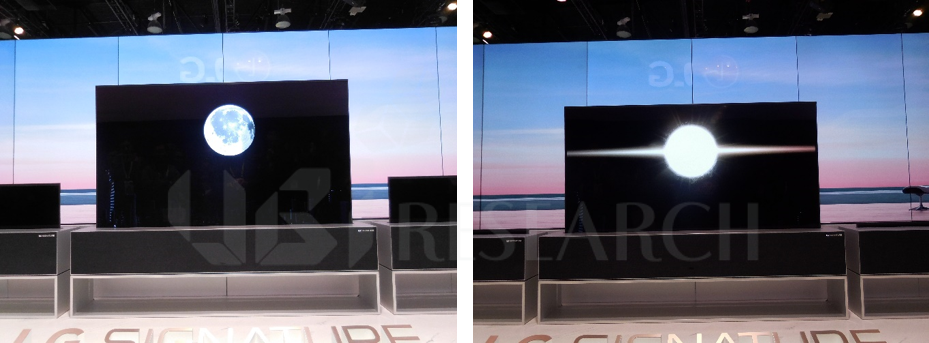
<LG Electronics, OLED TV R>
Last year, micro LED TVs became more prominent. In addition to Samsung Electronics, Sony, TCL and Hisense exhibited micro LED TVs this year. It seems that the gap of micro LED TV technology between Korean companies and Chinese companies is only about one year. In the micro LED TV market based on assembly technology that does not require special manufacturing technology, China, which is the world’s best LED industry and infrastructure, is expected to dominate the market soon.
However, as LG Display has a unique OLED TV manufacturing technology, which has a very complicated panel structure and manufacturing process, the technological gap between Korea and China is expected to be more than five years difference. In this situation, OLED TV R, released by LG Electronics, once again realizes that Korea’s OLED technology is the best in the world.
On the other hand, TV companies’ display of OLED TVs, except for LG Electronics, has stagnated. These companies are not yet receiving 8K OLED panels and rollable OLED panels from LG Display. Even Sony does not have any special features, only OLED TVs that are well known so far.
As a result, the CES TV show was notable only for LG Electronics.
It is judged that LCD TV using mini LED that TCL has released can compete with OLED TV in this exhibition. The contrast ratio is displayed as 1,000,000: 1 similar to OLED TV. Black is a very good product that has a vibrant color and contrast ratio similar to OLED TV. However, a holo-effect was found around the bright screen displayed on the black desktop. It is a phenomenon that the surroundings appear to spread brightly. As it is invisible to non-specialists, it is competitive in price and is a product that can compete well with OLED TVs.
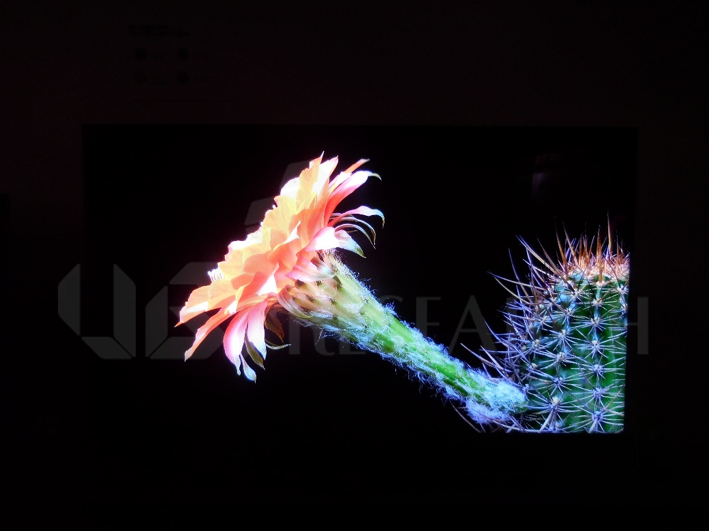
< TCL, 8K QLED TV with mini LED>
What is the next-generation display poised to outshine OLED?
/in Focus on /by olednetThe micro LED, QLED and hologram, which are referred to as the next generation displays, were presented at the seminar entitled ‘Recent Trends in Display and Vehicle Display Technology’ hosted by UBI Research on the 14th.
Under the theme ‘Technical Issues of micro LED Display and Market Trend’, professor Moon Dae-gyu of Soonchunhyang University said, “Micro LED can be realized in high resolution and it is easy to implement curved display or flexible display because there is no limit of panel shape and size” He added “When applying micro LED to a display, high resolution is feasible even on a small substrate size, so that it can be applied to VR, etc.” and expected “When applied to a public display, it will be able to escape from the method of tiling many display panels”. However, there remain some technical problems such as the problem of transferring and connecting millions of LED chips quickly and accurately, the deviation problem of color and luminous efficiency between LED chips, and the technical problem of implementing an active matrix for the application of a display.
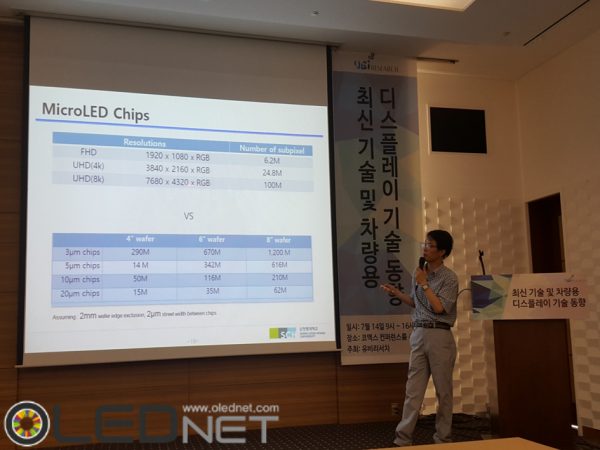
<Professor Moon Dae-gyu of Soonchunhyang University>
Next, Dr. Hwang Do-Kyung of Korea Institute of Science and Technology(KIST), Dr. Bae Wan-ki, senior researcher of KIST, and Dr. Oh Min-Suk of Korea Electronics Technology Institute(KETI) announced the manufacturing principle of quantum dot and the possibility of self-emitting QLED using it. Dr. Hwang said, “The quantum dot has the advantage of not only color change depending on the size and but also narrow half width.” “Self-emitting QLED can display higher color purity than OLED.” he added.
Dr. Bae expected “If research is carried out on an enterprise scale, the speed of technology development will increase more rapidly.” saying that “At present, the efficiency of quantum dot devices is continuously improving, but the life span is insufficient compared to OLED.”
“We need the next generation display technology to follow the LCD and OLED,” said Dr. Oh Min-Seok of Korea Electronics Technology Institute(KETI). He added “QLED is attracting much attention as a next-generation display, but there remain such issues as too much focus on the development of emitting devices, the lack of solution process-related devices and technologies, and the non-cadmium-based high-efficiency blue light emitting devices”.
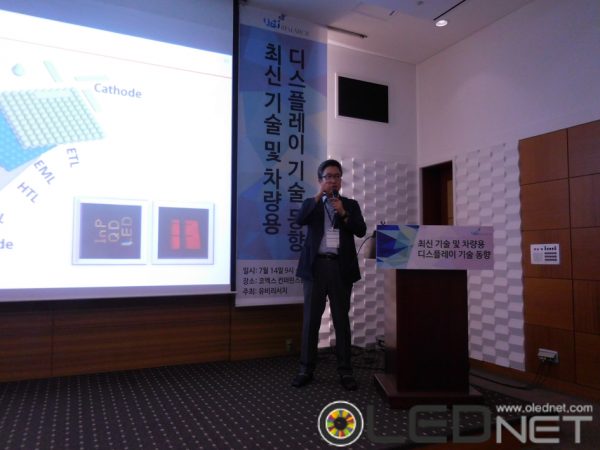
<Dr. Oh Min-Seok of Korea Electronics Technology Institute(KETI)>
As the last speaker, Kang, Hoon-Jong, team leader of Korea Electronics Technology Institute(KETI) explained the digital hologram technology and its application, and emphasized that a display panel capable of expressing the hologram is necessary to implement it. He said “We have a holographic printer or a microscope but there is no enough technology to apply it to TV”. Then, he closed his presentation saying “We need to develop a film for hologram first and then a functional design that can implement the screen.”
During the presentation about the next generation display, many of the speakers emphasized the importance of cooperation and participation among schools, research institutes and companies in order to overcome technical problems and realize them as actual displays. The display competition is expected to become even more intense in the future, as R&D in micro OLED, QLED, and hologram, which are considered as the next generation display, is concentrated.
영문 풋터
UBI RESEARCH / CEO:Choong Hoon Yi / Business License Registration Number 220-87-44660
ADDRESS: A-1901, Samho Moolsan Bldg, 83, Nonhyeon-ro, Seocho-gu, Seoul, Republic of Korea (Zip) 06775 TEL:+82-2-577-4390 / E-MAIL:marketing@ubiresearch.com

